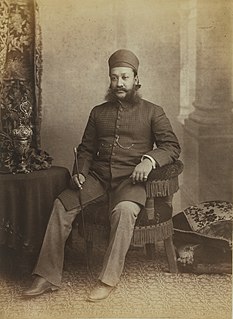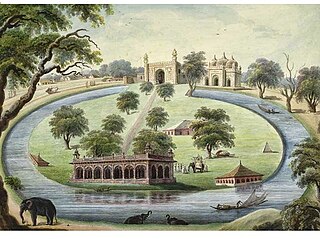Masjid-e-Aktharunnissa Begum, otherwise Ameerpet Mosque, is a very old and famous mosque in Ameerpet, Hyderabad, India, established by the Nawab family in memory of Aktharunnissa Begum Saheba wife of Nawab Farooq Ali Khan in her estate at Ameerpet X road. (FOUNDER NAWAB MOHD HYDER ALI KHAN (HYDER NAWAB )
The mosque is situated on the main road of Ameerpet in the commercial and educational hub of Hyderabad. The mosque is famously known for organising feasts in Ramadan during iftar for people who come to offer prayers from last several years.
Every Day of Ramzan https://www.thebetterindia.com/60971/ramzan-iftar-dinner-hyderabad-mosque/
The mosque is situated next to the new landmark of Hyderabad i.e. " Ameerpet metro Station".

Nawab, also spelled Nawaab, Navaab, Navab, Nowab, Nabob, Nawaabshah, Nawabshah or Nobab, is a Royal title indicating a sovereign ruler, often of a South Asian state, in many ways comparable to the western title of King. The relationship of a Nawab to the Emperor of India has been compared to that of the Kings of Saxony to the German Emperor. In earlier times the title was ratified and bestowed by the reigning Mughal emperor to semi-autonomous Muslim rulers of subdivisions or princely states in the Indian subcontinent loyal to the Mughal Empire, for example the Nawabs of Bengal. The title is common among Muslim rulers of South Asia as an equivalent to the title Maharaja.

Azam Jah, Damat Walashan Sahebzada Nawab Sir Mir Himayat Ali Khan Siddiqi Bahadur Bayaffendi was the eldest son of the seventh and last nizam of Hyderabad, Mir Osman Ali Khan, Asaf Jah VII and Sahebzadi Azam unnisa Begum, daughter of Sahebzada Mir Jahangir Ali Khan Siddiqi.

Bhopal State was an Islamic principality founded in the beginning of 18th-century India by the Afghan Mughal noble Dost Muhammad Khan. It was a tributary state during 18th century, a princely salute state with 19-gun salute in a subsidiary alliance with British India from 1818 to 1947, and an independent state from 1947 to 1949. Islamnagar was founded and served as the State's first capital, which was later shifted to the city of Bhopal.

Afzal ad-Dawlah, Asaf Jah VMir Tahniyath Ali Khan Siddiqi was the ruling Nizam of Hyderabad, India, from 1857 to 1869.

Nawab Fazal Nawaz Jung Bahadur was a noted Hyderabadi politician and financier during the period of the Nizam of Hyderabad Mir Osman Ali Khan, Asaf Jah VII.
Nawab Syed Ghulam Muhammad Ali Khan I Bahadur Mansur-Ud-Daullah was twice Nawab of Banganapalle in India.

Ameerpet is a residential hub located in the north-west part of Hyderabad, Telangana. Basically was gifted by then 6th Nizam of Hyderabad.

Sir Viqar ul-Umara, Iqtidar ul-Mulk, Iqbal ud-Dowla, Secundar Jung, Nawab Muhammad Fazl-ud-din Khan Bahadur, was the Prime Minister of Hyderabad from 1893 to 1901, and also served as the Amir e Paigah from 1881 to 1902.
Nawab Qasim Jan was a courtier in the royal courts of Mughal Delhi. He first lived in Lahore, attached to the court of the Governor, Moin-ul-Mulk, in the 1750s, thereafter he moved to Delhi, and joined the court of Delhi, in reign of Mughal Emperor, Shah Alam II.
Nawab Saheb Kunta is a district of Hyderabad, India. The neighbourhood is located in a low-lying area of the Old City and has been developed since 1978, fully developed locality with all shops, schools, and hospitals. The area is prone to waterlogging and flooding, which sometimes leads to problems with the supply of drinking water. As it is a majority Muslim population the municipality does not do much as compared to Ravindra colony which is nearby

The Spanish Mosque, also known as Masjid Iqbal Ud Daula or Jam e Masjid Aiwan-E-Begumpet, is a mosque within the Paigah Palace, Begumpet, Hyderabad, India.

Motijhil, also known as Company due to its association with the East India Company, is a horse-shoe shaped lake in Murshidabad, West Bengal, India. It was created by Nawazish Muhammad Khan, the son-in-law of Nawab Alivardi Khan. He also constructed a precious palatial palace beside this lake which is called the Sang-i- dalan which is also known as the Motijhil Palace. It is located at the bend of this lake. It was used as the residence of Nawazish and Ghaseti Begum, Nawazish's beloved wife. It is said that after Nawazish died, Ghaseti Begum lived here until Nawab Siraj ud-Daulah took over the palace and seized the residents' in 1756 AD. With this money he built a similar lake with a beautiful palace, Hirajheel, on the opposite side of the Bhagirathi River. The palace has a lofty gateway, a mosque known as the "Shahamat Jang" and the Kala Masjid and some other buildings which were all built by Nawazish. This palace was built in 1740. As far as etymology is concerned, the palace has been named so as it was built using black basalt pillars which were brought from the ruins of Gaur. Thus, it was given the name of Sang-i-Dalan or the Stone Palace. This palace was then decorated with different varieties of flower plants and precious marbles.

The Chawk Mosque is a mosque in the city of Murshidabad, India. It was founded in 1767 AD by Munny Begum, wife of Nawab Mir Zafar. Earlier in this place Nawab Murshid Quli Khan had built the "Chahel Sutan", which was the city's forty pillared audience hall. The mosque still recalls the stories of the ruling days of the Nawabs and still holds on its glory of the past.

Begumpur Mosque is a mosque located in Madurai Road, Begampur in Dindigul, the administrative headquarters of the Dindigul district in state of Tamil Nadu. Constructed in the Mughal architectural style, the mosque was built by Haidar Ali. The mosque is named after Ameerunnisa Begum, the younger sister of Hyder, who is buried in the mosque during 1766.
Lucknow is a city of imambaras as it has a large number of imambaras among which are some very famous.

The Musheerabad Masjid, is a mosque located in the Musheerabad locality of Hyderabad, India. The original portion was constructed in 1626 AD by Ibrahim Quli Qutb Shah, the fourth Sultan of the Qutb Shahi dynasty and is identical to the Hayat Bakshi Mosque located in Hayathnagar area of Hyderabad.
The localities and neighborhoods of Hyderabad have unique oral histories, dating to the time of the Qutb Shahi dynasty, over 400 years ago, and are named after various people and things. Some are named after a major building or structure in the locality, others named for individuals. The names are mostly in Telugu and Urdu, the major languages of the city. This is a list of localities, neighborhoods and streets of Hyderabad and their etymology.

Jama Masjid, a congregational mosque, is located at Motijhil, Murshidabad, West Bengal, India.

Aiwan-i Begumpet also known as Chiraan Fort Palace, and Devdi Fareed Nawaz Jung or Devdi Nazir Nawaz Jung was built in 1880 by Sir Viqar-ul-Umra, a Paigah nobleman who served as Prime Minister of Hyderabad. The palace was built after the construction of Falaknuma Palace gifted to the sixth Nizam of Hyderabad Mir Mahbub Ali Khan, Asaf Jah VI. Devdi is one of the complex in the Paigah Palace residence house of the Paigah Nobelity, In the hierarchy of nobles of Hyderabad, the Paigah family ranked immediately next to the ruling family of Nizams.